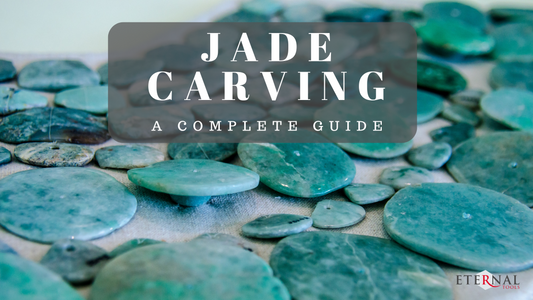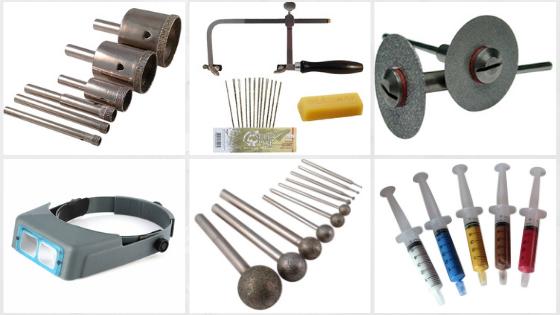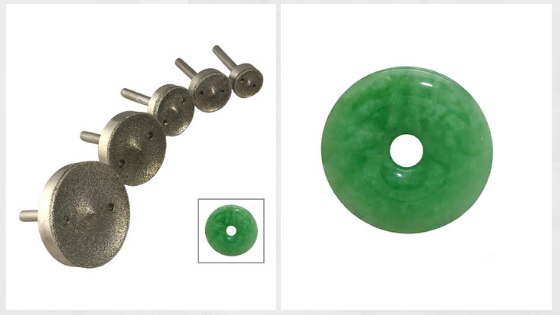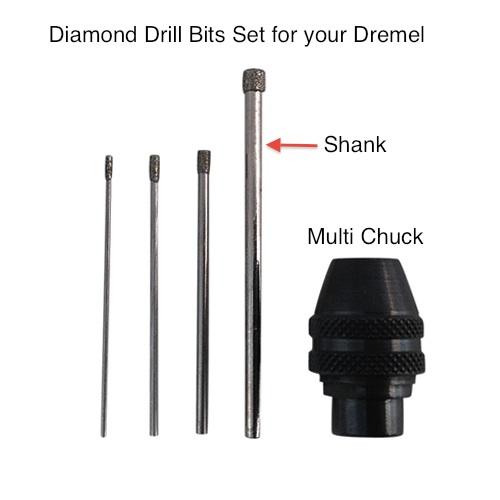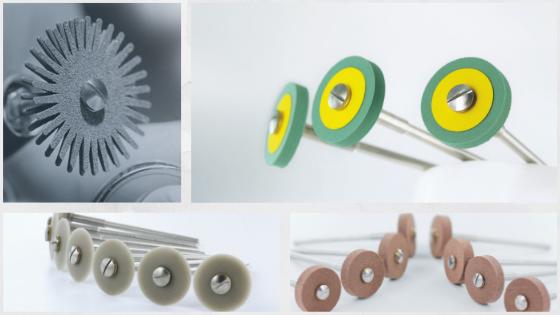What Is Jade?
Jade is an ornamental mineral mostly associated with its green varieties. In the jewellery trade, many opaque green stones are incorrectly named “Jade”. Jade has been mined and used for centuries, but it was only in 1863 that a French mineralogist determined that there were only two minerals that could be referred to as ‘Jade’: Nephrite or Jadeite.
Jadeite
- Jadeite has about the same hardness as quartz (between 6-7 Mohs hardness).
- It is rarer and more expensive than Nephrite and may be a white-grey green, leafy green, blue or blue-green, emerald green, lavender, pink, red, orange, greenish-black or black.
- The translucent emerald green ‘Imperial Jade’ is globally considered the rarest and most valuable.
- Myanmar and Guatemala are the main sources of modern gem jadeite.
Nephrite
- Nephrite is slightly softer than Jadeite (between 6-6.5 Mohs hardness).
- Nephrite generally occurs in creamy white (known in China as "mutton fat" Jade), mid- to deep olive green, brown and black.
- Also referred to as New Zealand Greenstone.
- Canada provides the major share of modern nephrite Jade.
Jade Carving
What is Jade Carving?
Jade carving falls under the Hardstone Carving category - a form of artistic carving of predominantly semi-precious stones that incorporates both Jewellery making and Sculpture.
Why Choose Jade?
Apart from its cultural symbolism, jade is an excellent choice for crafts and jewellery making due to its unique colour, clarity, pattern and nearly indestructible strength. The very toughness of jade makes it ideally suited for fine, intricate carving.
What Can You Carve with Jade?
Jade is suitable for the creation of pendants, bracelets, rings, earrings, necklaces, and statuettes. Its hardness allows for the cutting of chains from solid blocks of stone, and even paper-thin designs are achievable. Jade has been a classic choice for the creation of plates, bowls, and vases for centuries.
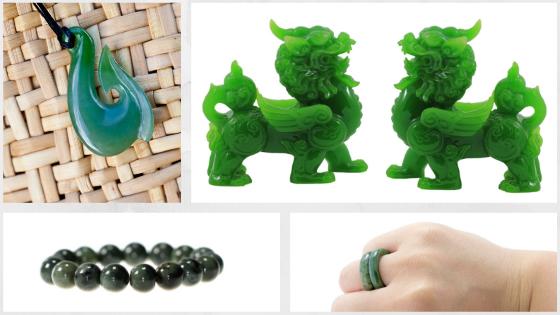
Jade Carving Tools
Unless you have some Chinese bone, bamboo, and stone instruments to abrade your jade stone, you will have to embrace modern technologies to carve Jade. More on lapidary techniques including carving, faceting, tools and supplies can be found in our article 'Lapidary: Guide to Stone Cutting'.
As Jade is rated between 6 and 7 on the Moh’s hardness scale, you will need a material rated at 10 to cut, shape and polish Jade. For this, Diamond tools are essential.
The 10 Essential Tools for Jade Carving
- Safety Glasses and Dust mask (to protect against debris and dust)
- High-quality Rotary tool with Flexible Shaft (such as a Dremel, Pendant Drill or Micro Motor.
- Frame Saw and Diamond Wire Hand Saw Blades (for cutting)
- Diamond Cutting Wheels or Diamond Slitting Discs (for cutting, shaping and outlining)
- Diamond Burrs (for carving, engraving, grinding, de-burring and shaping)
- Diamond Drills (for drilling holes and diamond twist drills for enlarging holes - useful for bead making)
- Polishing Wheel or Diamond abrasives such as hand pads or cloth (for polishing and buffing)
- Polishing Compounds or rotary tool diamond polishers (for finishing)
- Decent Bench Light (for enlightenment!)
- Headband Magnifier (if you’re working on small-scale items)
- Permanent marker or Chinagraph Pencil (to trace the design onto the workpiece)
How to Carve Jade/Jadeite
The carving of jade can be seen as a 3-step process:
- Cutting the shape
- Carving (Abrading) the details of the design
- Polishing the surface
Jade Carving 101
- The workpiece is cut to shape using diamond wire or a diamond cutting disc and ground to shape using diamond tools such as diamond burrs. Alternatively, a pre-cut cabochon can be used and then carved. (For intaglio or seal engraving rings this would be ideal)
- Trace your design onto your work piece using a permanent marker or Chinagraph pencil.
- Using a rotary drill (a flexible shaft is highly advisable) and your diamond burrs, you can start carving your design into the workpiece.
- Water must be used as a lubricant throughout the cutting and carving process.
- Any number of diamond burrs can be used to outline your design, the most popular being the diamond ball burrs.
- Diamond point burrs can be used to engrave intricate and filigree lines.
- Diamond cone burrs and diamond wheel burrs will deepen outlines.
- Diamond cylinder burrs and diamond wheel burrs can be used to remove the background material.
- Diamond Nail Head Burrs are ideal for top faceting work.
- For drilling holes into the Jade, you will need to use diamond drill bits and diamond core drills.
- Intricate designs can be cut manually using a diamond wire handsaw.
Troubleshooting Tips when Carving Jade
- Diamond tools should never be run dry, as excessive heat will shorten their life cycle.
- Using water throughout as a lubricant will reduce Jade dust and keep your diamond tools running smoothly.
- Jade dust should never be inhaled – always use personal protective equipment such as a dust mask or respirator.
- Investing in a flexible shaft for your rotary tool will ensure a comfortable grip and keep the rotary tool body away from the water.
- Both Jadeite and Nephrite often have interspersed hard and soft areas causing the classic "orange peel" appearance - Polishing with finer grades of diamond tooling is the best remedy for this problem.
- Carving is a manual job and this means your body posture is vital.
- Invest in a headband magnifier as your designs are as intricate as your eyes will allow.
- Create ample room for movement at your workbench.
How to Carve Jade with a Dremel
The Dremel rotary tool is the ideal tool for Jade Carving. It allows for carving, polishing, cutting, grinding, engraving, drilling, and sanding.
Dremel offers a wide range of accessories ideal for carving Jade (Multi Chucks, Flexible Shafts, Drill Presses and Collect Nut accessories.) plus the multitude of sanding bands, polishers, burrs, bits, drills etc are numerous and do not have to be Dremel branded for you to use in your Dremel Rotary drill. See the above list of Jade Carving Tools for some of the accessories suitable to use in your Dremel.
Other helpful articles for learning about the different accessories for use in your Dremel are as follows:
- 4 Tips for Polishing using your Dremel Rotary Tool or Flex Shaft
- Complete Guide to Your Dremel Rotary Tool
Dremel Carving 101
- Simply insert and fasten your diamond cutting disc, diamond burr or diamond drill bit into the chuck or collet of the Dremel. (I recommend the Dremel Multi Chuck).
- The flexible shaft allows for a comfortable grip and a distance between the rotating bit and the main body of the Dremel tool.
- Select the appropriate rotation speed for the Dremel to match the surface and bit accessory and start carving. Helpful note: Diamond tools must be run at a slow speed to preserve the life of the tool and prevent the diamond grit from burning off. (We recommend not exceeding 10,000 rpm)
- Be sure to lubricate the workpiece and diamond tool frequently with water.
- Be sure to wear safety glasses and a dust mask while carving any material. wear finger tape to protect your fingers from cuts and abrasions
Jade Cutting Tools
Various Jade cutting tools are available to suit your project size and budget. wear finger tape to help protect your fingers from minor cuts and abrasions:
- Jade can be cut to shape, manually, using diamond wire handsaw blades.
- Jade can be cut, mechanically, by using diamond cutting wheels or slitting discs attached to a rotary tool.
- Specialised Multi-functional Mini Table Saws are available for cutting jade.
- Industrial slab saws and Lapidary machines are available to cut bigger jade pieces to size.
Jade Carving Machines
Upgrading from the old trusted rotary tool?
Specialised, mini-multifunctional jade carving machines are available to combine functions of cutting, carving and polishing into one.
Going to the next level you might be heading into CNC Territory:
CAD programs are used to render complex jade carving designs that are replicated by computer-aided carving routers. These Jade CNC carving machines allow for precise and multiple duplications of complex designs.
How to Polish Jade
Polishing jade is done using an abrasive and finishing off with a polishing compound.
Jade polishing can be done with a mechanical work wheel or by the manual use of diamond hand polishing pads and cloths.
- A rotary tool with felt buffing pads attachments and diamond paste.
- Polishing Machines (Buffing Machines).
- Lapidary polishing machines.
Polishing machines are dressed with specific grit drums, discs or belts – ranging from rough to ultra-smooth.
The process is finished by using a matching buffing felt pad and polishing compound.
Polishing Jade 101:
- Attach a 120-grit wheel, drum, sander roll, disc or belt to your polishing machine.
- Start with light pressure and increase until you see sanding in progress.
- Move the direction of the jade at least 90 degrees every 15 seconds to curb gouges, chips and undercutting of the stone.
- Change the sanding material to the next grit level and repeat the process moving from the 120-grit through 300, 600 and finishing up with the 1,200-grit material.
- A buffing pad can be added to the polisher or you can use diamond hand polishing pads to continue by hand.
- Apply the polishing compound during the buffing process - whether a bar or paste-type product.
- Hold the Jadeite against the buffing pad, moving the stone in all directions until shiny and mirror-like.
- A chrome oxide polishing compound or diamond polishing paste works best for Jade.
Polishers suitable for use on Jade:
- Diamond Lapping Paste
- Diamond Hand Pads
- Diamond Cloth
- Diamond Polishers
- Soft Wheel Polishing Discs
- Felt, cotton and calico polishing wheels, bobs and points
- Bezel set stones: Radial Pumice Twist Discs and Pumice Polishing Discs
Caring For And Cleaning Your Jade Jewellery
You don’t have to clean Jade every time you wear it – it is a tough mineral that has stood the test of time.
Caring for and Cleaning Jade 101:
- Wipe Jade with a soft cloth and clean it only when you notice soiling.
- Avoid acids, alcohol or regular jewellery cleaning solutions of any type.
- We recommend using lukewarm water and a few drops of mild liquid soap on a cloth to wipe clean.
- Use a soft-bristled toothbrush for tight spaces.
- Wipe dry with a clean cloth.
- Store Jade in a jewellery bag or in a separate jewellery box compartment to prevent scratching or contamination.
Jade Around The World
Jade has been prevalent in other cultures, featuring prominently in India, Mexico, Korea and South East Asia.
In Central America, the Mayans and the Aztecs used jadeite for medicinal purposes, religious artefacts and as jewellery.
The early Spanish conquistadors observed the natives of Central America carrying the stone for its reputation to assist with ailments of the loins and kidneys. The Spanish term ‘piedra de ijada’ translates to ‘loin stone’. The English word Jade was derived via French and Latin from this Spanish term.
The Lake Baikal region of Russia is home to a Spinach-green Nephrite known as "Russian Jade".
Jade is prominent in the Maori culture of New Zealand, associated with nobility and wealth. Known as "pounamu", "greenstone" or "New Zealand Jade’’. Pounamu has been the material of choice for Maori tools, such as chisels, fishhooks, and weapons. Ornamental pendants (hei kakï) are carved and made to this day.
The Emperor’s Stone
In the West, precious gems such as diamonds and rubies were worn by Rulers and Royalty. In the East, Jade is considered to be the imperial gem of choice.
Chinese refer to Jade as "yu", which directly translates as "heavenly" or "imperial".
In China, Jade has been a symbol of status, spirituality, purity and health for more than 9000 years.
Jade has been worked in China since the Stone Age, first utilised for its toughness in the making of weapons and tools.
By 3000 BC, Jade was elevated to Royal Gem status and put to use in carvings, decorations, and jewellery for the imperial families.
Jade Carving Value
Most gemstones are priced in terms of their carat weight. Jade, however, is unique in that it is traded by the piece. The amount of Jade in the world is not unlimited in quantity and therefore carries an excellent investment value.
Working with Jade is not just therapeutic, but also allows the carver to create a piece that is durable enough to be passed on to many generations. These characteristics make Jade truly, in the words of the Chinese: more valuable than gold.

